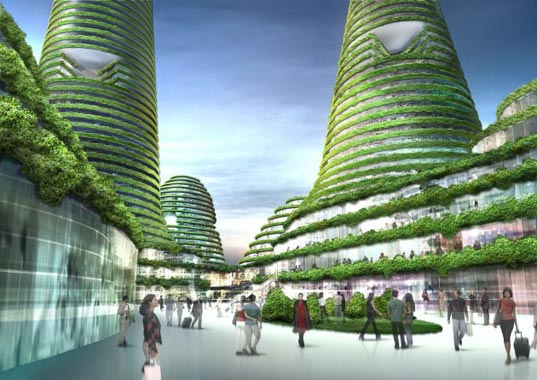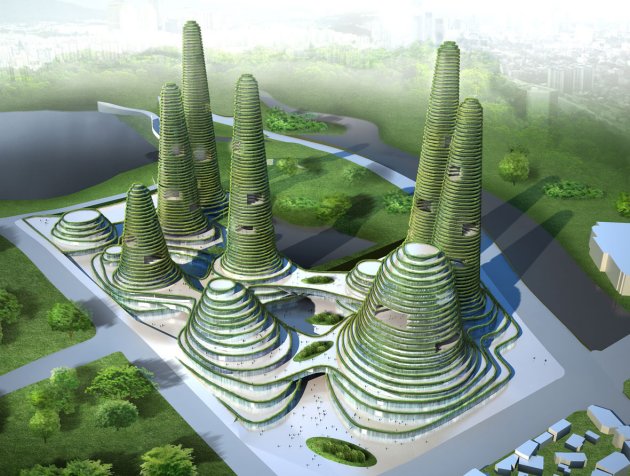At the end of this post you’ll find reference to a MOOC (Massive Open Online Course) that starts September 17. Free, no mandatory tests. Think of this post as a preface, why I’m so intrigued.
Dutch firm MVRDV‘s winning design for Gwanggyo City Centre to be built south of Seoul, South Korea via matternetwork
__________________________________________
Just as I was writing,
I’ve been bitten — in some rather tender spots of my psyche – by the future. Specifically by a surprisingly non-dystopian one. Physics of the Future by Michio Kaku,
eight wild turkeys wandered into the back yard.
Life is rich in messages, if only you can jot them down before they bolt off into the bushes. The turkeys did not bolt. As I was going to regale you with tales of how technology will bring us a golden year 2100, I will first tell you the Tale of Unexpected Consequences.
A dirty one. A drywell had to be re-excavated out back, it left a couple of bald patches in the crabgrass. A few weeks ago. For scale: we joked about Granny buried there. Today a rafter of turkeys comes pecking their way into the yard, grabbing morsels, hanging out. Until one of them settles into a dirt patch. I don’t know if you’ve ever seen a wild turkey’s foot, but it’s big enough to hoist a grown sparrow. So when the turkey settled in the dirt there was a lot of leg action, scratching a spot. One by one its fellow birds each found itself a wallow, vigorously perfected by scraping out more dirt from time to time. It seemed to be catching, like yawns.
They settled in. Wild turkeys have a reputation around here for take-no-prisoners territoriality. So we are now gently encouraging them to think of home as elsewhere. I dearly hope this works.
__________________________________________
With this in mind, let’s return to predictions of the future. Michio Kaku is a theoretical physicist and co-founder of String Field Theory. He’s also a humanist who devotes significant time to making a technological future less vague and frightening to lay people. My imagined Future, influenced by William Gibson and confreres, has been of a dismal global ghetto, plagued by war, gangs and fear. It may turn out that way. But Kaku has pointed my thoughts in a sunnier direction and I’ll share some with you.
In Kaku’s book Physics of the Future (copyright 2011) you’ll find predictions that make you sigh — because Google Glass and self-driving cars now already exist. Beyond that his focus turns to specific technologies and where he expects them to take us in the decades ahead. Medicine, energy, nanotechnology, artificial intelligence. Via a wealth of detail and amazements it all leads toward a Planetary Civilization — which is where I get hooked. Now this is in the way-out future — but that’s what I’ve had no tangible notion of.
You know how today’s political cartoonists seem stuck using 1930s fat cats to represent today’s runaway capitalists? Gordon Gekko doesn’t wear a top hat or have a black suit buttoned across his Santa belly. Neither do the Koch brothers. With Obama it’s the ears, with Clinton the hairdo. We can “get” the raging feminist, the absent-minded professor, the campus stud. How do today’s robber barons manage to stay invisible as a class?
In just this way Michio Kaku has provided me my first indelible image of a functional future. The dismal blank gives way to complicated forms. Do I think Kaku’s infallible? Humans are fallible. And turkeys can camp in your yard.
Think, it takes more than turkeys to derail history’s big wheels.
__________________________________________
We may not experience it this way but we’re living in a time of epic upheavals. The Industrial Revolution on speed juice. If you go back to that time and compare the social changes to ours you can begin to appreciate our situation. Fifty-five years after Thomas Jefferson signed the US Declaration of Independence Charles Darwin stepped aboard the HMS Beagle. Fifty-five years after the marvel of the Eniac computer was announced (1946) the iPod came on the market. In 2056, fifty-five years after the iPod’s nativity, what?
At the top of this post you’ll see an envisioned future, a city that hasn’t yet been built. Cities have traditionally accreted — Jericho, Mohenjo-daro, Rome — but in our future-facing time planned cities become feasible.
Which leads me to the MOOC I mentioned at top — a view of the future that starts with the past. MIT is offering a free online version of its course A Global History of Architecture. It examines architectural innovations in terms of what was going on in a society at the time — the technology, the belief systems. City planning and architecture will hugely determine how our future feels to live in — I see this course as a foundation to think about how spacious our future may feel.
A MOOC is a Massive Open Online Course. I went looking for one because I don’t like being outside looking in on the phenomenon. Global Architecture was a serendipitous find and I’m eager to dive in. MITX: 4.605x A Global History of Architecture: Part 1
A note to my readers: Please consider taking this course yourselves. The professor aims to start a global conversation about architecture. Being in at the beginning sounds like fun. You’ll also find links to more about MOOCs in the look further section below.
Another view of MVRDV’s Gwanggyo City Centre, showing the lake and greenbelt — and also conventional city buildings off in the mist
________________________________
look further:
MOOC List – “A complete list of Massive Open Online Courses offered by the best universities and entities.”
edX – A joint scholarly program of MOOCs. Participating collages include Harvard, MIT, U. of California at Berkeley, and Cornell.
About the Global History of Architecture MOOC
Scientific American, August 2013 — has a batch of articles related to MOOCs.
TED.com has a number of talks about education, many marvelous.
Wild turkeys — wise old Benjamin Franklin thought they’d make better national symbols than the eagle with its raptor beak and talons.




